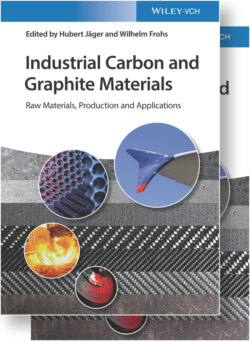Читать книгу Industrial Carbon and Graphite Materials - Группа авторов - Страница 274
6.1.2.2. Physical and Chemical Properties 6.1.2.2.1 Physical Properties
ОглавлениеPetroleum coke is a grayish‐black solid matter of very varied compositions. Generally, a distinction is made between petroleum coke from fluid and flexicoking plants and petroleum coke obtained from delayed coking processes. The petroleum coke produced from delayed coking units is also called green coke. The fluid and flexicokers supply a fine‐grained petroleum coke that has a high level of isotropy and in general ash content between 1 and 4 wt%. The grain consistency of these cokes is high; the content of volatile combustible matter (VCM) is low and hardly exceeds 5 wt%. In contrast, petroleum coke from delayed coking units is normally characterized by both, high porosity and anisotropy. The VCM content is between 7 and 14 wt%; it is only set to <6 wt% for needle coke production. The ash content is low, generally <0.1 wt%. The bulk density of normal‐quality petroleum coke is around 0.8–0.9 g/cm3. If however, the feed stream to the delayed coking units is rich in high molecular asphaltenes, a nonporous isotropic petroleum coke is the result, which has a high bulk density of 1.2–1.4 g/cm3. The formation of this shot coke is feed dependent, and the quality can be counteracted to an extent by manipulating operating conditions.
Another basic form of petroleum coke is calcined coke. Calcined coke is a product derived from green coke. Here, the hydrocarbons have been removed by heating green coke under reducing conditions in kilns or hearths to over 1300 °C.
The classification of petroleum coke types derived from delayed cokers into the following categories based on its usage:
Fuel grade (cement manufacturing, power generation).
Anode grade (consumed as anodes in aluminum industry).
Electrode grade (used in electric arc furnace [EAF] during steel manufacture).
Petroleum coke can also be classified by appearance as:
Shot coke (small spherical balls called “beebes”).
Sponge coke (amorphous, may contain shot beebes).
Sponge/honeycomb coke (regular or anode‐grade coke having amorphous structure).
Needle coke (crystalline, clusters of aligned needles).
The definition is not precise [1]. A differentiation with regard to isotropy and crystal structure is logical. There is a graded transition from shot coke (mainly isotropic; amorphous, no crystal structures formed; hardly any pores) to needle coke (high anisotropy; regular crystal structures, containing a great number of fine pores, crystallite size of the order of 4–7 nm).
Sponge and needle cokes have to be calcined before they can be used for aluminum or steel production. Calcined coke is a product derived from green coke. Here, the residual hydrocarbons have been removed by heating green coke under reducing conditions in kilns or hearths to over 1300 °C.
Typical properties for the various types of coke are shown:
Fuel grade:VCM (wt%) 14 maximum; moisture (wt%) 8–12; HGI 30–70; sulfur (wt%) 3–7.5
Anode grade:Green: HGI 60–100Calcined: sulfur (wt%) 3.5 maximum; ash (wt%) 0.4 maximum; Ni (ppm wt) 200 maximum; V (ppm wt) 350 maximum; VBD (g/cc) 0.87 minimum; real density (g/cc) 2.05 minimum
Needle coke:Calcined: sulfur (wt%) < 0.5; N (wt%) < 0.5; ash (wt%) < 0.1; real density (g/cc) 2.10–2.14; CTE°× 10 − 7 (30 125 °C) 2.5
Petroleum coke results from a thermal cracking and polymerization reaction. After going through the mesophase, a solid crystalline form is formed, which, contrary to indications [2], does not plastify again. Coking only occurs in the contained VCM particles. If their fraction exceeds 15%, the release of this petroleum coke at high temperatures gives the impression of a plastic state of aggregation. By treating petroleum coke with steam and hot water, those components that are slightly water soluble can be washed and steamed out of the petroleum coke.
